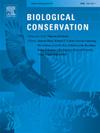评估壁虎对国际野生动物贸易的易感性:一个基于特征的新框架
IF 4.4
1区 环境科学与生态学
Q1 BIODIVERSITY CONSERVATION
引用次数: 0
摘要
国际野生动物贸易(IWT)导致生物多样性丧失,往往在物种被正式评估或为人所知之前就对其造成影响,尤其是新发现的物种。由于缺乏事先知识或法律保护,这些物种可以在没有后果的情况下进行交易,爬行动物,尤其是壁虎,面临着来自外来宠物和传统药物交易的压力。我们开发了一个野生动物贸易易感性框架(WTSF),采用气候变化脆弱性评估中基于性状的方法来评估物种性状如何影响它们的可取性和对贸易的暴露。我们将WTSF应用于1886种已知的壁虎物种,这是IWT的主要目标。该框架确定48%的物种极易受到贸易影响。与易感性相关的关键特征包括进化独特性和体重。易感和敏感物种最集中的地区包括马达加斯加、东南亚和新几内亚。目前的贸易数据库中缺少三分之一最敏感的壁虎物种,可能是由于需求低、可及性有限或执法不力。这种缺失突出了现有物种知识和监测在确定内务贩运风险最大的物种方面的局限性。我们的框架提供了一个早期预警系统,在生物易感物种出现在贸易之前对其进行标记,并可应用于不同的分类群体。本文章由计算机程序翻译,如有差异,请以英文原文为准。
Assessing gecko susceptibility to international wildlife trade: A novel trait-based framework
International wildlife trade (IWT) drives biodiversity loss, often affecting species before they are formally assessed or well-known, particularly newly described ones. These species can be traded without consequence due to a lack of prior knowledge or legal protection and reptiles, especially geckos, face pressure from the exotic pet and traditional medicine trades.
We developed a Wildlife Trade Susceptibility Framework (WTSF), adapting trait-based methods from climate change vulnerability assessments to evaluate how species traits influence their desirability and exposure to trade. We applied the WTSF to 1886 known gecko species, a group heavily targeted by IWT. The framework identified 48 % of species as highly susceptible to trade. Key traits linked to susceptibility included evolutionary distinctiveness and body mass. Regions with the highest concentrations of susceptible and sensitive species included Madagascar, Southeast Asia, and New Guinea.
A third of the most sensitive gecko species are absent from current trade databases, likely due to low demand, limited accessibility, or effective enforcement. This absence highlights the limitations of existing species knowledge and monitoring in identifying those most at risk from IWT. Our framework provides an early warning system to flag biologically susceptible species before they appear in trade and can be applied across taxonomic groups.
求助全文
通过发布文献求助,成功后即可免费获取论文全文。
去求助
来源期刊

Biological Conservation
环境科学-环境科学
CiteScore
10.20
自引率
3.40%
发文量
295
审稿时长
61 days
期刊介绍:
Biological Conservation is an international leading journal in the discipline of conservation biology. The journal publishes articles spanning a diverse range of fields that contribute to the biological, sociological, and economic dimensions of conservation and natural resource management. The primary aim of Biological Conservation is the publication of high-quality papers that advance the science and practice of conservation, or which demonstrate the application of conservation principles for natural resource management and policy. Therefore it will be of interest to a broad international readership.
 求助内容:
求助内容: 应助结果提醒方式:
应助结果提醒方式:


